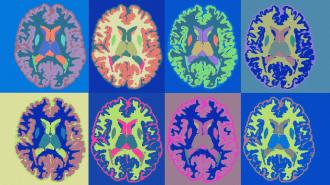An “inverse vaccine” that reversed the signs of multiple sclerosis (MS) in mice is now in human trials — and if it works, the technology could unlock cures for a variety of autoimmune disorders.
The challenge: The immune system is supposed to protect us against infections and disease by identifying and attacking dangerous invaders, such as viruses, but in the estimated 10% of the population with an autoimmune disorder, it also attacks healthy cells, tissues, or organs.
There are more than 80 known autoimmune disorders, including MS, type 1 diabetes, and Celiac disease. With few exceptions, they are incurable, and treatments to address their symptoms typically suppress the immune system, resulting in side effects and increased risk of infections.
An estimated 10% of the population has an autoimmune disorder.
Inverse vaccines: Researchers at the University of Chicago are developing a treatment for autoimmune disorders that they call an “inverse vaccine,” and according to a newly published paper, it completely reversed signs of MS in mouse models of the disease.
A version of the inverse vaccine designed to treat Celiac disease has already proven to be safe and tolerable in a phase 1 trial, and a phase 2 trial to test its efficacy against Celiac is underway. A phase 1 trial for MS is also ongoing.
How they work: The part of a virus, bacterium, or other pathogen that triggers the immune system is called the “antigen.” Vaccines work by introducing an antigen in a way that triggers the immune system, but doesn’t make you sick. If you ever encounter the virus later, the immune system will already be ready to attack.
In people with autoimmune disorders, something harmless — like a gluten protein in bread — can trigger an immune response, just like a dangerous antigen, resulting in damage to the body. Sometimes, a part of the body’s own cells is the trigger.
“We can attach any molecule we want to pGal and it will teach the immune system to tolerate it.”
Jeffrey Hubbell
The Chicago team’s idea was to create a treatment for autoimmune diseases that would do the opposite of a regular vaccine: instead of using antigens to teach the immune system to attack pathogens, they would use them to teach the system to tolerate harmless molecules.
To do that, they turned to “peripheral immune tolerance,” a phenomenon in which the liver adds tags to cells that die naturally to tell the immune system to ignore them. This prevents the immune system from going into overdrive trying to clear cells that are going to leave the body on their own in time anyways.
“Rather than rev up immunity as with a vaccine, we can tamp it down in a very specific way.”
Jeffrey Hubbell
In previous research, they’d discovered that a sugar molecule, called pGal, looks a lot like a fragment of one of the old cells the liver usually tags as “ignore.” By attaching the sugar to molecules that trigger unwanted immune reactions in people with autoimmune disorders, they found they could get the liver to tag those molecules the same way.
“The idea is that we can attach any molecule we want to pGal and it will teach the immune system to tolerate it,” said lead author Jeffrey Hubbell. “Rather than rev up immunity as with a vaccine, we can tamp it down in a very specific way with an inverse vaccine.”
The results: In previous research, the team demonstrated how an inverse vaccine for Celiac disease — pairing pGal and a gluten protein — appeared to induce immune tolerance in mice, leading them to move on to human trials.
In mouse models of MS, the inverse vaccine stopped the immune system from attacking the rodents’ myelin.
For the new study, they developed an inverse vaccine for MS. In MS, the immune system attacks myelin, which surrounds and protects nerve fibers, so they used a part of a myelin protein for their inverse vaccine.
When they delivered it to the livers of mouse models of MS, it worked as hoped, causing the animals’ immune systems to stop attacking their myelin. Their nerves were able to function normally again, and their symptoms reversed.
Looking ahead: The fact that the inverse vaccine for Celiac disease already appears safe and tolerable in people is encouraging, but we won’t know for sure whether or how well it works until after larger trials wrap up. It’ll take even more trials to know if this approach works for many autoimmune disorders, as the Chicago team hopes.
Researchers don’t always know what exactly is triggering an autoimmune reaction, and it’s not clear how this approach would work without an obvious antigen — like the gluten protein — to include in the inverse vaccine.
Still, the preclinical research is promising, and if the approach could lead to a cure for even a fraction of people with autoimmune disorders, it could have a huge impact given how many are living with these conditions.
We’d love to hear from you! If you have a comment about this article or if you have a tip for a future Freethink story, please email us at tips@freethink.com.
